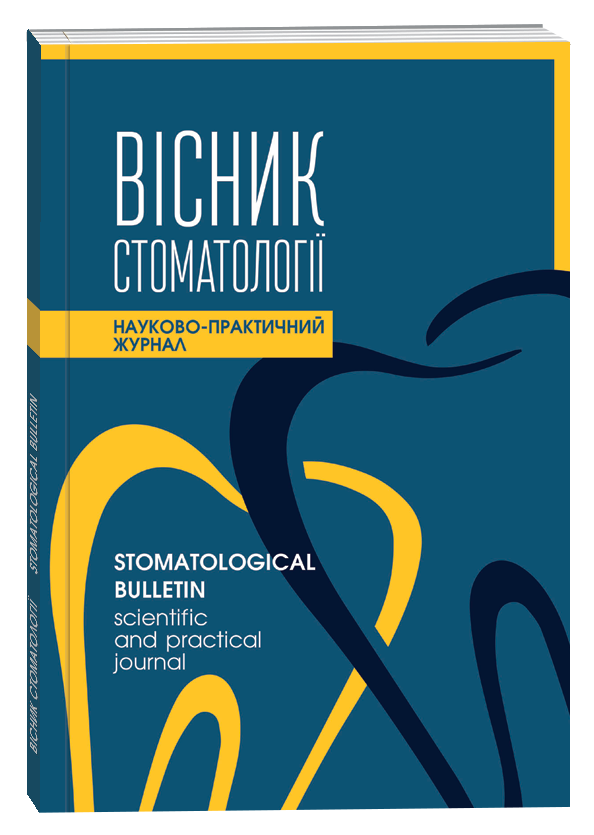PREVALENCE OF PERIODONTAL TISSUE DAMAGE IN CHILDREN WITH CONCOMITANT DIFFUSE NON-TOXIC GOITER
DOI:
https://doi.org/10.35220/2078-8916-2022-43-1.13Keywords:
periodontium, diffuse non-toxic goitre, childrenAbstract
Iodine deficiency diseases constitute an important medical and social problem, since a significant part of the territory of Ukraine is characterized by biogeochemical indicators of low iodine content in the environment, which is the cause of hypothyroidism development. At the same time, there are many other factors that can trigger the thyroid disorders in children [1–2]. Epidemiological studies carried out in the Carpathian region have shown that iodine deficiency of varying degrees is specific to this area [3–6]. Professor M.M. Kovalev’s in-depth study of the causes of goitre in Bukovyna showed that along with iodine deficiency, macro- and micronutrient deficiencies associated with certain regions play an important role [7]. Iodine deficiency promotes goitrogenesis and decreases the secretory capacity of the thyroid gland. As a result of reduced intrathyroid iodine in the gland, diiodothyrosine synthesis decreases and monoiodothyrosine increases, the hormone ratio increases due to an increase in the more biologically active triiodothyronine. This compensates for the euthyroid state against the background iodine deficiency. An adaptive manifestation of iodine deficiency is goitre, considered being the main sign of iodine deficiency; as iodine deficiency or thyroid hormone requirements increase, goiter size increases [8–10] and more severe forms of thyroopathology develop. Iodine deficiency is common in many countries of the world. The objective of the research was to determine the occurrence and severity of periodontal tissue damages in children with comorbid diffuse non-toxic goitre (DNG). Materials and Methods. To determine the dynamics of changes in clinical parameters with age, two age groups, 12 and 15 years, of which 180 children with DNG, and 80 somatically healthy children have been examined. Conclusions. Regarding periodontal tissue damages by tartar as one of the leading factors of inflammatory processes in gums and alveolar bone, the following should be noted: there is a low level of periodontal tissue damage in the younger children and in somatically healthy children of both ages. The incidence of hard dental deposits in adolescents with DNG is moderate, and high in the case of DNG, grade II.
References
Малий Д.Ю., Антоненко М.Ю. Епідеміологія захворювань пародонту: віковий аспект. Український науково-медичний молодіжний журнал. 2013. № 4. С. 41–43.
Каськова Л.Ф., Бережна О.Е., Новікова С.В. Проблеми виникнення хронічного катарального гінгівіту у дітей та шляхи їх вирішення. Полтава : ТОВ НВП «Укрпромторгсервіс», 2015. 86 с.
Остапко О.І. Стан тканин пародонту у дітей та підлітків, які проживають у різних регіонах України. Новини стоматології. 2015. № 1(82). С. 78–83.
Хоменко Л.О., Біденко Н.В., Остапко О.І., Голубєва І.М. Дитяча пародонтологія: стан проблем у світі та Україні. Новини стоматології. 2016. № 3(88). С. 67–71.
Roberts M.W. Dental health of children: where we are today and remaining challenges. J Clin Pediatr Dent. 2008. No. 32(3). Р. 231–234.
Davidovic B., Ivanovic M., Jancovic S., Lecic J. The assessment of periodontal health in children age 12 to 15. Serbian Dent J. 2012. No. 59(2). Р. 83–89.
Сущенко А.В., Лепехина О.А., Лепехина Л.И. Результаты исследования распространѐнности патологии пародонта у детей. Международный журнал экспериментального образования. 2015. № 5. С. 41–42.
Veiga K.A., Porto A.N., Matos F.Z., et al. Carie Experience and Periodontal Status in Children and Adolescents with Cleft Lip and Palate. Pediatr Dent. 2017. No. 39(2). Р. 139–144.
Kaur A., Gupta N., Baweja D.K., Simratvir M. An epidemiological study to determine the prevalence and risk assessment of gingivitis in 5-, 12- and 15-year-old children of rural and urban area of Panchkula (Haryana). Indian J Dent Res. 2014. No. 25(3). Р. 294–299.
Moreau A.M., Hennous F., Dabbagh B., Ferraz Dos Santos B. Oral Health Status of Refugee Children in Montreal. J Immigr Minor Health. 2019. No. 21(4). Р. 693–698.
Цепов Л.М., Михеева Е.А., Голева Н.А, и др. Хронический генерализованный пародонтит: ремарки к современным представлениям. Пародонтология. 2010. № 1(54). С. 3–7.
Грудянов А.И., Фоменко Е.В. Этиология и патогенез воспалительных заболеваний пародонта. Москва : МИА. 2010. 96 с.
Дзампаева Ж.В. Особенности этиологии и патогенеза воспалительных заболеваний пародонта. Кубанский научный медицинский вестник. 2017. № 24(5). С. 103–110.
Костригина Е.Д., Зюлькина Л.А., Иванов П.В. Современный взгляд на этиопатогенез пародонтита (обзор литературы). Известия вузов. Поволжский регион. Медицинские науки. 2017. № 3(43). С. 118–128.
Jehani Y.A. Risk factors of periodontal disease: review of the literature. International Jornal of Dentistry. 2014. P. 1–9.
Виженко Є.Є., Зайцев А.В., Ваценко А.В., Рябушко О.Б., Костиренко О.П. Сучасні уявлення про етіологію та патогенез хвороб пародонту. Світ медицини та біології. 2013. № 2. С. 207–211.









